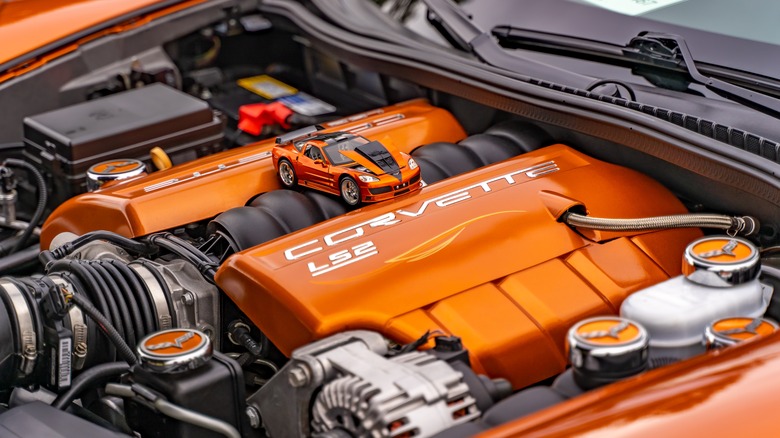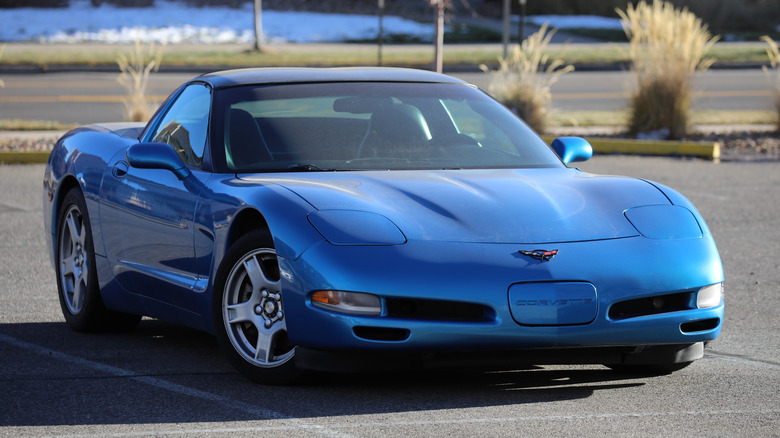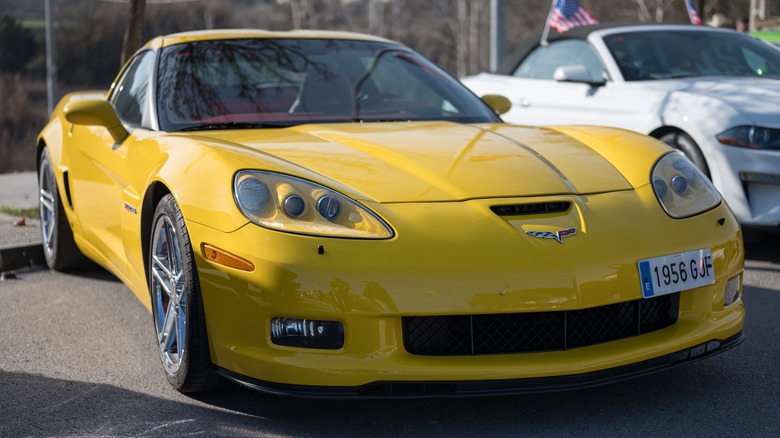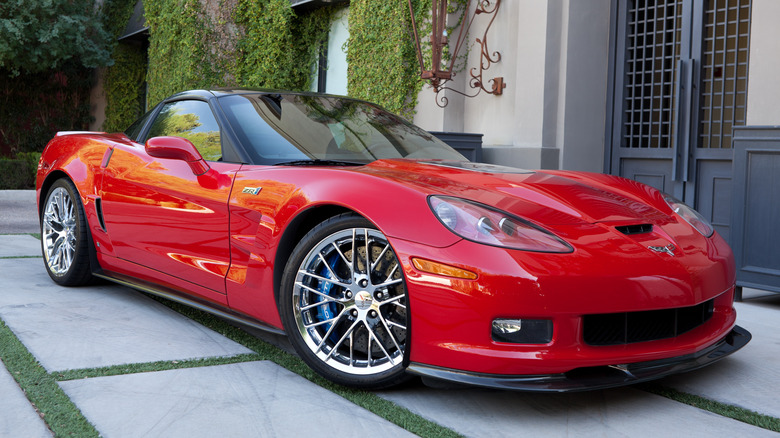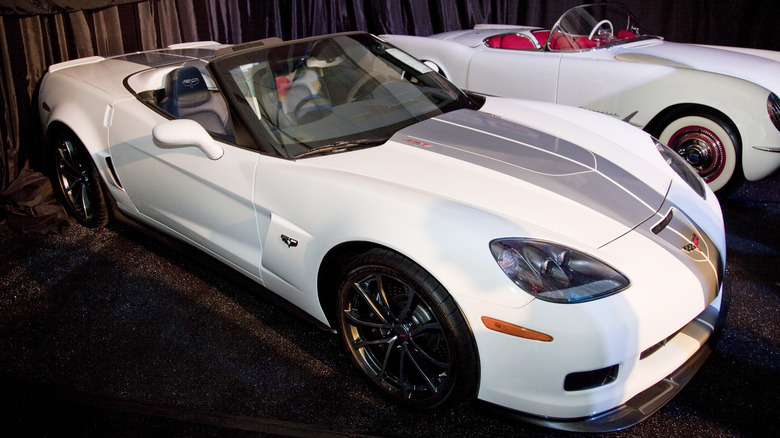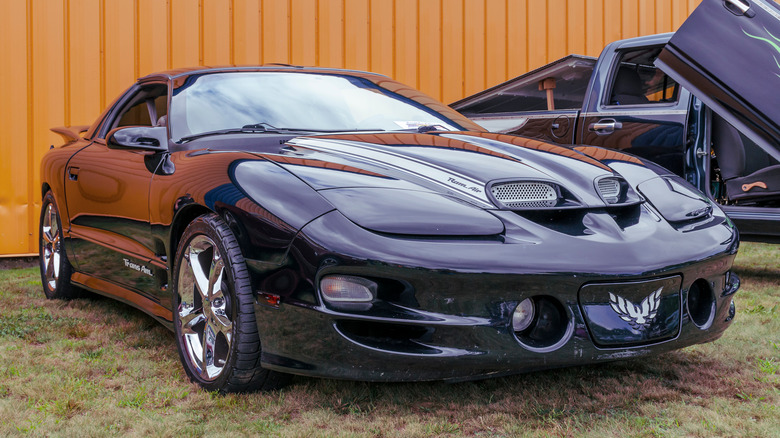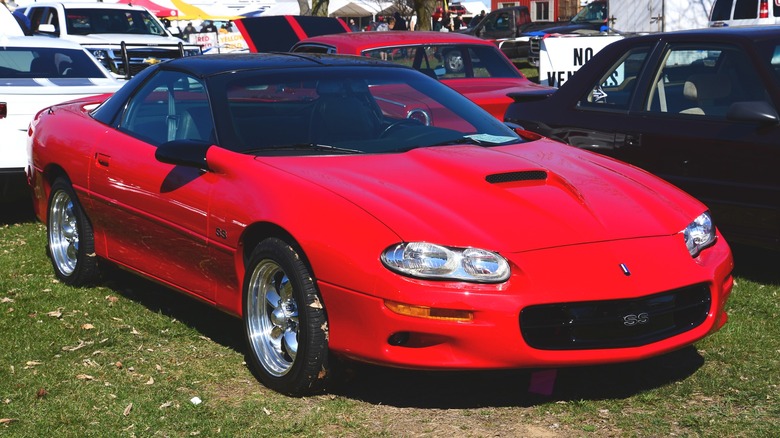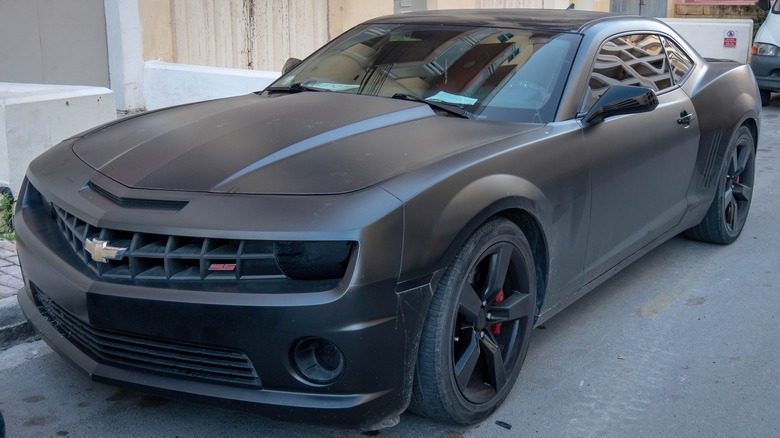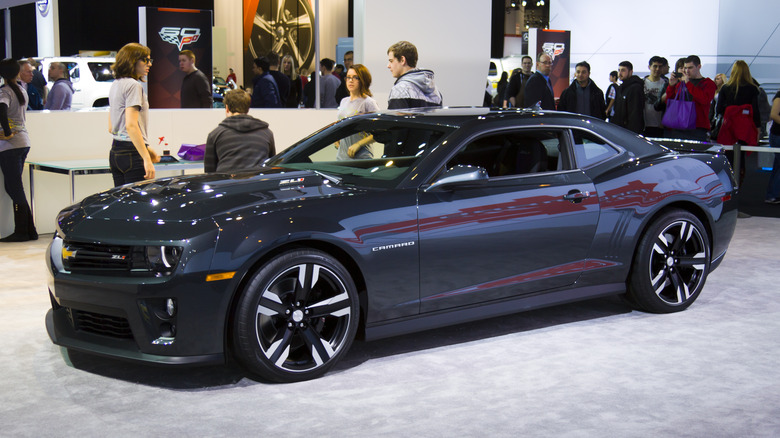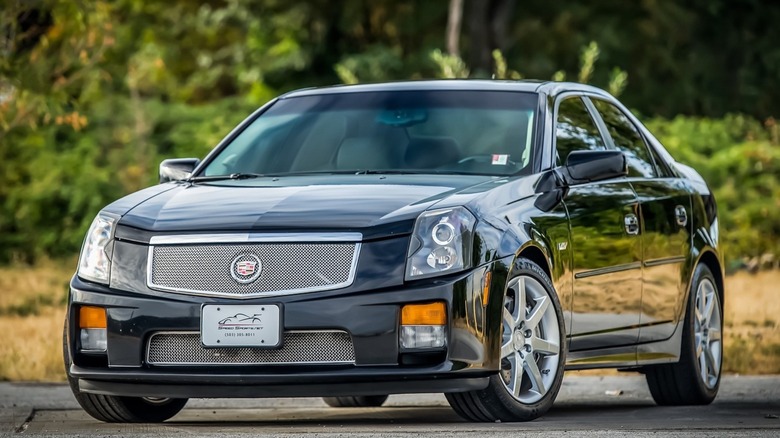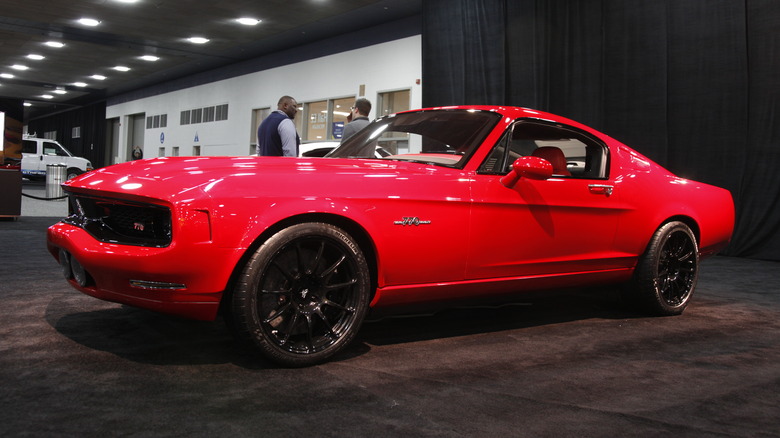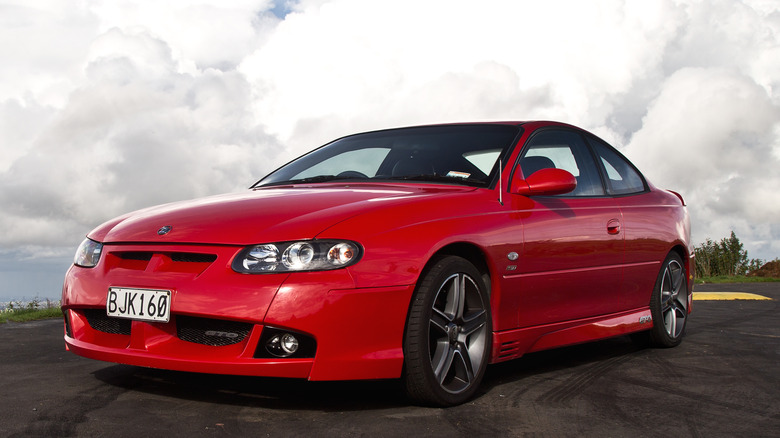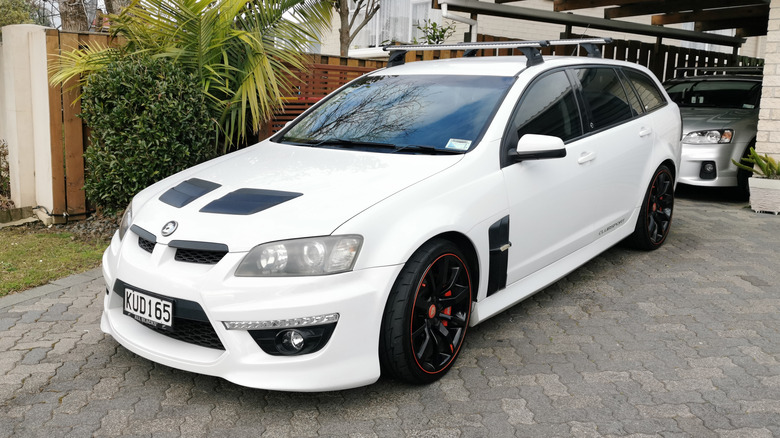Every Muscle Car Powered By A General Motors LS V8 Engine
General Motors' LS V8 engines are likely among the most well-known and well-regarded V8 engines ever. Not only is it capable of handling huge horsepower, but its popularity also means that there's third-party hardware to allow car owners to drop an LS into almost any engine bay.
However, the LS isn't just a popular engine for budding drag racers trying to get 500 (or more) hp out of their cars. Starting in the late 1990s, GM's LS V8s made their way into a good amount of muscle cars, from obvious names like the Chevrolet Corvette and Camaro to lesser-known cars like the Holden GTO and Equus Bass 770.
For the purposes of this list, we decided to define a "muscle car" as a two- or four-door passenger car with performance aspirations. So that leaves out trucks (and truck-likes) such as the Chevrolet TrailBlazer SS and HSV Maloo as well as more sedate offerings like the Chevrolet Impala SS and Buick LaCrosse. It's not a perfect definition, but it's what we're working with. Either way, let's get started.
Chevrolet C5 Corvette and Corvette Z06 (1997 - 2004)
The fifth-generation C5 Corvette debuted in 1997 with an all-new GM V8 under the hood. Gone was the C4's LT engine, replaced by a new 5.7-liter LS1. The LS1 retained the LT1's pushrod design but introduced many changes, including a redesigned block alongside new cylinder heads, manifolds, and pistons. The result was a smaller and lighter engine producing 345 hp and 350 lb-ft of torque, which climbed to 350 hp and 375 lb-ft in 2001.
This was also the year that GM introduced the higher-end Corvette Z06, with a modified LS1 GM called the LS6. The new engine sported visual and mechanical changes from the LS1, including larger fuel injectors, higher compression, modified pistons, and a redesigned block. The LS6 provided the 2001 Z06 with 385 hp and 385 lb-ft of torque, climbing to 405 hp and 400 lb-ft of torque in 2002. The Z06 had more than just a new engine, though, sporting a revised drivetrain and new suspension, all in the service of the LS6's increased power.
The LS1 and LS6 were available in the fifth-generation Corvette and Corvette Z06 for the entirety of their production runs before GM kicked things up a notch with the next-generation 'Vette.
Chevrolet C6 Corvette and Corvette Z06 (2005 - 2013)
GM introduced the sixth-generation Corvette in 2005 with a new LS engine alongside other changes such as a more aerodynamic body and exposed — instead of pop-up — headlights. The C6 Corvette came with a 6.0-liter LS2 capable of 400 hp and 400 lb-ft of torque, but that engine didn't last long. GM refreshed the C6 'Vette in 2008, introducing the new 430 hp and 424 lb-ft LS3 into the engine bay. Other upgrades included better manual and automatic transmissions and a more luxurious interior, earning the C6 a top-three spot in our ranking of every Corvette generation.
Unsurprisingly, Chevrolet introduced the C6 Corvette Z06 in 2006. The C6 Z06 used carbon-fiber panels to create a slimmed-down version of the base Corvette with even more power than the previous-generation Z06 thanks to a new engine. The hand-built 7.0-liter LS7 was one of the best engines ever put in a Corvette, with titanium connecting rods, aluminum cylinder heads, and a titanium valvetrain resulting in 505 hp and 470 lb-ft of torque.
The LS7 stayed in the C6 Z06 until Chevrolet stopped using it in the Corvette in 2013, as did the LS3 in the base Corvette. These would be the last LS engines to feature in the Corvette engine bay, with the seventh-gen Corvette moving to GM's then-new LT engines.
Chevrolet Corvette ZR1 (2009 - 2013)
The C6 Corvette Z06 may have been the king of the hill when it debuted, but its place at the top was short-lived. First announced in 2007, the Chevrolet Corvette ZR1 took its place at the top of the Corvette horsepower rankings when it went on sale in the summer of 2009, with 638 hp and 604 lb-ft of torque available from a new supercharged LS9 engine.
Like the Z06's LS7, the 6.2-liter LS9 was a hand-built engine coming out of GM's Michigan-based Performance Build Center. The LS9's main party piece was its Roots supercharger, which offered a 2.3-liter displacement and 10.5 psi of boost. The LS9 also had an aluminum block, a forged steel crankshaft, titanium connecting rods, and a dry-sump oiling system, all of which helped sustain its impressive power output and allowing the LS9 to become one of the most powerful engines GM ever built.
GM engineers were likely very proud of the LS9, if the transparent panel in the ZR1's otherwise weight-saving carbon fiber hood was anything to go by. Of course, the ZR1 wasn't only about the engine, as it also came with a dual-disc clutch, beefed-up gearbox, magnetorheological dampers, and carbon-ceramic brakes. All of these factors helped make the ZR1 more livable on the road and easier to eke out fast lap times from on the track than the Z06.
Chevrolet Corvette 427 Convertible (2013)
Chevrolet celebrated the Corvette's 60th anniversary in 2013 in one of the best ways possible — by making a limited edition drop-top it called the Corvette 427 Convertible. As one of several special edition C6 Corvettes released over the model's life, the 427 Convertible harkened back to the 1969 Corvette 427 in name and engine displacement, with the Z06's naturally aspirated 7.0-liter LS7 under the hood.
As in the Z06, the 427 Convertible's LS7 made 505 hp and 470 lb-ft of torque. Still, the 427 Convertible wasn't just a Z06 with the hood chopped off. While the engine, Michelin tires, and cross-drilled brakes were from the higher-end Corvette, the 427 used the base car's steel chassis instead of the Z06's aluminum frame. The 427 also featured some carbon-fiber panels from the even higher-end ZR1 to create a hybrid of everything GM had to offer, Corvette-wise at least, in 2013.
Chevrolet only built 2,552 Corvette 427 Convertibles in 2013, with around 1,000 shipping with an optional 60th Anniversary Package. The Anniversary Package, which was only available on the highest-end trim levels, was a mostly cosmetic affair, with details such as Arctic White paint, suede-style microfiber steering wheel, blue interior stitching, and gray brake calipers. Chevrolet offered a graphics pack on top of that, which added racing stripes in Pearl Blue across the whole car.
Pontiac Firebird Trans Am and Formula (1998 - 2002)
Chevrolet's Corvette may have been the most high-profile recipient of GM's LS engines through the late 1990s and early 2000s, but it wasn't the only GM car to feature the then-new LS1 during that time. The company also blessed the fourth-generation Pontiac Firebird Trans Am with the LS1 for the last few years that those cars were made, elevating it above its third-generation predecessor.
Debuting in 1993, the Pontiac Firebird Trans Am first rolled off the line with GM's 5.7-liter LT1 V8 in the engine bay, which made 275 hp and 325 lb-ft of torque. Power climbed an extra 10 hp by 1997, but GM didn't stop there. Enter the LS1, which debuted in the Firebird Trans Am in 1998. GM didn't quite unleash the LS1's full potential in the Firebird, but 305 hp and 335 lb-ft of torque — or 320 hp with an optional Ram Air package — was a solid improvement over the old V8 and made the Trans Am plenty fast by 1998 standards.
GM also offered the LS1 in the Firebird's Formula trim, which offered all the Trans Am's upgrades over the base Firebird — including an optional six-speed transmission and the Ram Air performance package — but kept the base Firebird's aesthetics. The LS1 stayed for the rest of the generation until GM discontinued the Firebird in 2002. Pontiac itself wouldn't last that much longer, either, as GM shut it down before the end of the decade.
Fourth-generation Chevrolet Camaro SS and Z28 (1998 - 2002)
Like the similar but distinct Pontiac Firebird, Chevrolet's Camaro pony car also came in for some LS loving toward the end of its fourth generation. From 1998 to 2002, the fourth-generation Camaro – occasionally known by the less than flattering Catfish nickname — played host to the LS1 engine in two of its higher-end trims, namely the Camaro Z28 and Camaro SS.
The fourth-generation Camaro debuted in 1993 with either a V6 or V8, the latter only available in the Camaro's Z28 trim. The 5.7-liter LT1 V8 in the Camaro Z28 made 275 hp, which was healthy and powerful enough for the time. Of course, times and expectations change and just a year after introducing the LS1 to the Corvette, GM decided to give the Camaro a kick up the rear by introducing its new small-block V8 to the car in 1998.
Available in the 1998 Camaro Z28 and SS starting that year, the LS1 made 305 and 320 hp, respectively, with potential owners of the latter able to get an extra five hp from an optional exhaust only available on the SS. The SS also had a ram air hood, stiffer suspension, rear spoiler, and Goodyear F1 tires. Both LS1 fourth-gen Camaros came with a limited-slip differential as standard, with a six-speed manual transmission available at no extra cost. The LS1-Camaro combination lasted until 2002, when GM discontinued the model.
Fifth-generation Chevrolet Camaro SS and Z/28 (2010 - 2015)
The Camaro nameplate lay dormant for the rest of the 2000s, even as the Corvette went from strength to strength with new engines and models. Thankfully, it wouldn't stay that way forever, and GM's venerable pony car finally returned to dealer forecourts for the 2010 model year — with an LS V8, of course.
GM's revived Camaro came in three trim levels: LS, LT, and SS. The LS and LT sported a 3.6-liter V6, while the big boy SS had the C6 Corvette's 6.2-liter LS3 under the hood, making 426 hp and 420 lb-ft of torque with a manual transmission. Automatic Camaro SS cars had a 400 hp L99 engine instead, which was a variant of the LS3 with active fuel management and variable valve timing.
Chevrolet resurrected the Z28 as the Z/28 for the final two years of the fifth-gen Camaro's life. Unlike the fourth-gen Camaro, the fifth-generation Z/28 sat above the SS in the Camaro hierarchy, with a 7.0-liter LS7 making 505 hp and 481 lb-ft of torque in the engine bay. The Z/28 wasn't just about raw power, though, and it came with a selection of impressive components — including a high-end Multimatic suspension, grippy Pirelli tires, and carbon-ceramic Brembo brakes — and reduced weight to create a high-end track-oriented car. The sixth-generation Camaro debuted in 2016 and, like the Corvette, moved onto GM's new LT1 engine in the process.
Chevrolet Camaro ZL1 (2012 - 2015)
The Corvette wasn't the only GM muscle car to get a fire-breathing supercharged variant during the 2010s. Following in the footsteps of the Corvette ZR1, the Camaro ZL1 debuted in 2012 as a high-performance, high-horsepower version of the fifth-gen Camaro. However, where the 'Vette ZR1 sported an LS9, the ZL1 — named in reference to the infamous ZL1-powered 1969 COPO Camaro — had the 6.2-liter LSA instead.
Both engines were quite similar, sporting the same LS pushrod design, displacement, and forced induction. The LSA was ultimately a less powerful version of the LS9, with the main difference being the blower. In place of the 2.3-liter Roots blower on the LS9, the LSA featured a 1.9-liter supercharger, dropping power output to 580 hp and 556 lb-ft of torque.
Like its fifth-gen Z/28 counterpart, GM pitched the ZL1 as an all-around car and not just one for the drag strip. So, while the 580 hp certainly gave the Camaro ZL1 great straight-line performance, features like the third-generation Magnetic Ride suspension, advanced traction control systems, Goodyear Eagle F1 Supercar tires, limited-slip differential, and Brembo brakes made for a fast and great-handling car.
Cadillac CTS-V (2004 - 2014)
Cadillac's CTS debuted for the 2003 model year and was one of the earliest examples of the company's new Art & Science design philosophy, which married an angular, sporty design with a 3.2-liter, 220 hp V6 engine driving the rear wheels along with Nürburgring-tuned suspension and handling behavior. The CTS certainly wasn't a Cadillac of old, which GM hammered even further home when it unveiled the even better CTS-V the following year.
Out went the V6, and in came the 400 hp, 5.7-liter LS6 previously seen in the C5 Corvette Z06, to be later replaced by the LS2 in 2006. The CTS-V didn't just get a beefier engine, though — other changes such as a six-speed manual transmission as standard, Brembo brakes, tuned suspension, and Goodyear Eagle tires allowed the sedan to compete with European sports sedans from BMW and Mercedes-Benz.
GM put the CTS-V on ice for 2008, returning with a revamped CTS-V for the 2009 model year. The second-generation CTS-V came with the LSA engine, a detuned variant of the LS9 in the Chevrolet Corvette ZR1. The 556 hp, 551 lb-ft V8 took the refreshed CTS-V to a whole new level, with critics hailing the sedan's straight-line performance and prowess around the track. GM discontinued the LSA-powered CTS-V after 2014, with its third-generation successor — released in 2016 — sporting a supercharged LT4 engine.
Equus Bass 770 (2017)
The Equus Bass is likely the strangest — or, to be more charitable, most unique — car on our list. Unlike all the other cars, which were from big manufacturers, the Equus Bass was the brainchild of one person: Bassam "Bass" Abdallah, founder of Equus Automotive, for whom the car was named.
The Bass 770 was a retro-minded throwback with a design reminiscent of the Mustang fastback, right down to a horse badge not entirely dissimilar to that of Ford's iconic pony car. Each unit was to be hand-built, a process that allegedly required a minimum of 5,000 man-hours per car. If that weren't premium enough, Equus went for an aluminum chassis and body with carbon fiber inner panels to house the 6.2-liter LS9 engine and high-end leather interior. The Bass 770's LS9 made 640 hp, 605 lb-ft of torque, and delivered power via a six-speed transmission to meaty 285/40 Michelin Pilot Sport rear tires.
If all of this sounds cool, that's because it is. However, if that were the case, why has the world mostly forgotten the Bass 770? Well, the price may have had something to do with it — the Bass 770 started at around $250,000, alienating a huge swath of potential buyers.
HSV GTO Coupe and Coupe GTS (2002 - 2005)
Holden was an Australian subsidiary of General Motors that built a wide range of cars before going defunct in the late 2010s, including a handful of LS-powered ones. While most of Holden's offerings weren't quite performance-minded enough to make our list, the cars from its HSV (Holden Special Vehicles) division certainly were. Case in point are the HSV GTO and Coupe GTS.
The GTO debuted in 2002 as a high-performance version of the new third-generation Holden Monaro coupe. The original VY-series Monaro already had a 315 hp LS1 in its CV8 guise, but the GTO brought the LS1's output up to 350 hp. Power climbed to 380 hp in 2003, although this update didn't seem to bring much new to the table otherwise. The final version of the GTO Coupe came in 2004, alongside a new generation of VZ-series Holdens. The VZ GTO Coupe sported an LS2 rated at around 400 hp and 400 lb-ft of torque.
HSV also had a higher-spec version of the Monaro called the Coupe GTS available for a few years. The VY-series Coupe GTS had an LS-based Callaway C4B engine making 400 hp and 380 lb-ft of torque in 2002 but moved to a standard LS1 a year later for the Series II VY Holdens, albeit with similar power numbers. The Holden Monaro was also rebadged as the 2004 Pontiac GTO and 2005 Vauxhall Monaro for the U.S. and the U.K., respectively. Each sported a 400 hp LS2 in the engine bay.
HSV Clubsport and GTS (2000 - 2017)
The HSV Clubsport and GTS were Holden Commodore-based sedans and wagons that elevated the Commodore — which already used GM's LS engines — to true muscle car status with increased power, more aggressive styling, and suspension upgrades to go with the beefier engines.
The entry-level Clubsport was a mainstay of the HSV lineup since the 1990s, but the first LS-powered Clubsport came in 2000, with a 340 hp LS1 in the Commodore VX-based Clubsport. HSV moved to the LS2 in 2004, with the new engine increasing power for the Z-series Clubsport to 400 hp and 391 lb-ft of torque. HSV continued to move with the times, introducing an LS3 Clubsport in 2006 with 425 hp. The final major iteration of the Clubsport was 2016's Clubsport R8 LSA, which had 536 hp and 516 lb-ft of torque.
Owners seeking even more performance could have gone for the HSV GTS, which was a higher-output and more premium take on the Commodore. The GTS debuted in 2002 with a 400 hp LS1 before HSV introduced LS2- and LS3-powered versions in 2006 with 425 and 410 hp, respectively. Next, 2013 saw HSV bring the supercharged LSA to the HSV GTS, where it made 576 hp.
Australian Holden manufacturing ended in 2017, prompting HSV to release the GTSR and GTSR W1 as a farewell of sorts. The GTSR had the GTS' LSA but massaged to make around 585 hp, while the GTSR W1 was an LS9-powered beast with 635 hp and 601 lb-ft of torque. Both the Clubsport and GTS were also sold in the U.K. as the Vauxhall VXR8 and VXR8 GTS, respectively.
